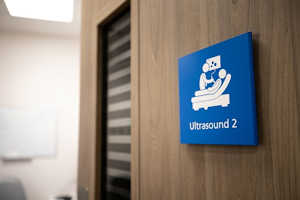Ultrasound studies generally range from 10 to 40 minutes, although complex examinations may require slightly more time.
Ultrasound

Your GP or hospital doctor might refer you to the Wood Green Community Diagnostic Centre (CDC) for an ultrasound scan. The CDC, based in The Mall in Wood Green, brings NHS diagnostic tests into the community.
Ultrasound scanning, often referred to as sonography, is a safe, non-invasive imaging technique that employs high-frequency sound waves to generate real-time images of your body's interior. This test is carried out by a sonographer, a health professional specialised in ultrasound imaging.
Find out more information about your scan type on these pages:
Having a pelvic ultrasound (transabdominal and transvaginal scans)
Preparing for an ultrasound scan
Preparation for an ultrasound scan varies depending on the area being examined. Comfortable, loose-fitting clothing is recommended.
Certain scans might require you to fast for a few hours, while others may necessitate a full bladder.
Always check specific preparation guidelines provided for the type of ultrasound procedure you're having.
Arriving for your appointment
We advise arriving 10 minutes before your scheduled time to process paperwork and confirm your appointment details. Note that waiting times may vary based on the type of examination.
Receiving your ultrasound results
Once the scan is complete, the sonographer prepares a report for your doctor. The sonographer's role does not include discussing the results with you.
Your referring doctor will share and explain the findings to you in the context of your overall health and medical history during your follow-up appointment. Please remember to arrange this important follow-up visit with your referring doctor.
Safety of ultrasound scans
Uses of ultrasound
From diagnosing various health conditions to guiding medical procedures and fertility treatments, ultrasound imaging finds extensive application across various medical disciplines including cardiology, endocrinology, gastroenterology, gynaecology, musculoskeletal, obstetrics, urology, and vascular.
From diagnosing various health conditions to guiding medical procedures and fertility treatments, ultrasound imaging finds extensive application across various medical disciplines including cardiology, endocrinology, gastroenterology, gynaecology, musculoskeletal, obstetrics, urology, and vascular.
The ultrasound machine
An ultrasound machine looks like a large computer on a movable trolley. It has a control panel with an array of dials and buttons. Depending on the type of examination, the sonographer selects a suitable transducer, or probe, which connects to the machine via cables.
The role of a transducer
The transducer plays a vital role in the ultrasound process. It emits high-frequency sound waves into your body and captures the waves that bounce back. This information is processed by the ultrasound machine to produce images of your internal organs.
Safety of ultrasound scans
Ultrasound has been a trusted imaging technique for almost three decades and is regarded as safe. It does not involve radiation and has not been associated with any harmful side effects. However, like any medical procedure, it should only be performed when medically necessary, and exposure should be limited to the minimum required for diagnosis.
Last updated03 Jan 2024

